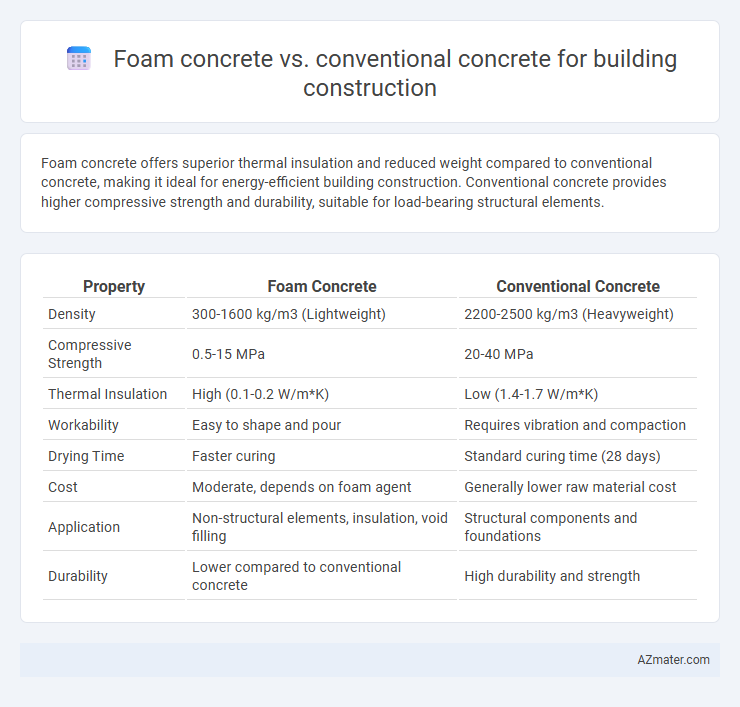Foam concrete offers superior thermal insulation and reduced weight compared to conventional concrete, making it ideal for energy-efficient building construction. Conventional concrete provides higher compressive strength and durability, suitable for load-bearing structural elements.
Table of Comparison
| Property | Foam Concrete | Conventional Concrete |
|---|---|---|
| Density | 300-1600 kg/m3 (Lightweight) | 2200-2500 kg/m3 (Heavyweight) |
| Compressive Strength | 0.5-15 MPa | 20-40 MPa |
| Thermal Insulation | High (0.1-0.2 W/m*K) | Low (1.4-1.7 W/m*K) |
| Workability | Easy to shape and pour | Requires vibration and compaction |
| Drying Time | Faster curing | Standard curing time (28 days) |
| Cost | Moderate, depends on foam agent | Generally lower raw material cost |
| Application | Non-structural elements, insulation, void filling | Structural components and foundations |
| Durability | Lower compared to conventional concrete | High durability and strength |
Introduction to Foam Concrete and Conventional Concrete
Foam concrete is a lightweight, aerated material created by mixing cement slurry with stable foam, resulting in reduced density and improved thermal insulation compared to conventional concrete. Conventional concrete consists of a mixture of cement, water, sand, and aggregates, offering high compressive strength suitable for structural applications. Foam concrete's cellular structure enhances sound absorption and fire resistance, while conventional concrete remains the standard for load-bearing construction due to its durability and strength.
Composition and Material Differences
Foam concrete consists of cement, water, and a foaming agent that introduces air bubbles, resulting in a lightweight, porous material with lower density compared to conventional concrete, which is composed of cement, water, sand, and aggregates like gravel or crushed stone. The inclusion of foam reduces the cementitious material density significantly, improving thermal insulation and reducing structural load. Conventional concrete's dense composition provides higher compressive strength but lacks the insulation and lightweight qualities intrinsic to foam concrete.
Density and Weight Comparison
Foam concrete has a significantly lower density, typically ranging from 400 to 1600 kg/m3, compared to conventional concrete which generally has a density of around 2400 kg/m3. This reduced density results in lightweight structures that decrease the overall load on foundations and structural components. Lower weight also facilitates easier handling, transportation, and installation, making foam concrete ideal for non-load-bearing walls and insulation purposes in building construction.
Strength Characteristics
Foam concrete exhibits lower compressive strength compared to conventional concrete, generally ranging from 0.3 MPa to 15 MPa, making it suitable for non-structural applications. Conventional concrete typically achieves compressive strengths between 20 MPa and 40 MPa, providing superior load-bearing capacity essential for structural elements. The reduced density of foam concrete results in lighter structures but compromises its strength characteristics when compared with traditional concrete.
Thermal and Acoustic Insulation Properties
Foam concrete offers superior thermal insulation compared to conventional concrete due to its lightweight cellular structure, which significantly reduces heat transfer and improves energy efficiency in buildings. Acoustic insulation is enhanced in foam concrete as its porous composition absorbs sound waves more effectively, minimizing noise pollution within structures. Conventional concrete, while structurally stronger, typically lacks the thermal and acoustic insulating properties provided by foam concrete, making foam concrete an optimal choice for energy-efficient and noise-sensitive construction projects.
Workability and Ease of Application
Foam concrete offers superior workability compared to conventional concrete due to its lightweight, flowable consistency that allows effortless pouring and shaping, particularly in complex forms or confined spaces. Its ease of application reduces labor time and costs, requiring simple tools and less vibration for compaction, unlike conventional concrete which demands more intensive mixing, handling, and finishing processes. These attributes make foam concrete highly suitable for projects prioritizing quick installation and adaptability on-site.
Durability and Longevity
Foam concrete offers enhanced durability due to its lightweight cellular structure, which provides excellent resistance to freeze-thaw cycles and reduces the risk of cracking compared to conventional concrete. Its lower permeability improves resistance to water ingress and chemical attack, extending the lifespan of structural elements in harsh environments. Conventional concrete remains highly durable in load-bearing applications but may require additional protective measures to achieve similar longevity in aggressive conditions.
Environmental Impact and Sustainability
Foam concrete significantly reduces environmental impact compared to conventional concrete by utilizing less cement, lowering carbon dioxide emissions, and incorporating recycled materials like fly ash. Its lightweight properties enhance thermal insulation, resulting in energy savings and reduced heating and cooling demands in buildings. Foam concrete's sustainability is further supported by its ability to minimize raw material extraction and reduce waste on construction sites, contributing to greener building practices.
Cost-Effectiveness and Economic Considerations
Foam concrete offers significant cost savings over conventional concrete by reducing material usage due to its lightweight property, which lowers transportation and labor expenses in building construction. Its excellent thermal insulation properties contribute to long-term energy cost reductions, enhancing overall economic efficiency for projects. While initial material costs for foam concrete may be slightly higher, the combined savings in structural support, handling, and energy expenses result in a more cost-effective solution compared to conventional concrete.
Best Applications and Use Cases
Foam concrete, characterized by its lightweight and high thermal insulation properties, is best suited for non-structural applications like void filling, roof insulation, and partition walls, reducing structural load and energy consumption. Conventional concrete, known for its high compressive strength and durability, is ideal for load-bearing elements such as foundations, beams, columns, and slabs in residential, commercial, and infrastructure projects. Selecting foam concrete or conventional concrete depends on specific project requirements, balancing factors like weight, strength, thermal performance, and cost-effectiveness.

Infographic: Foam concrete vs Conventional concrete for Building construction
 azmater.com
azmater.com